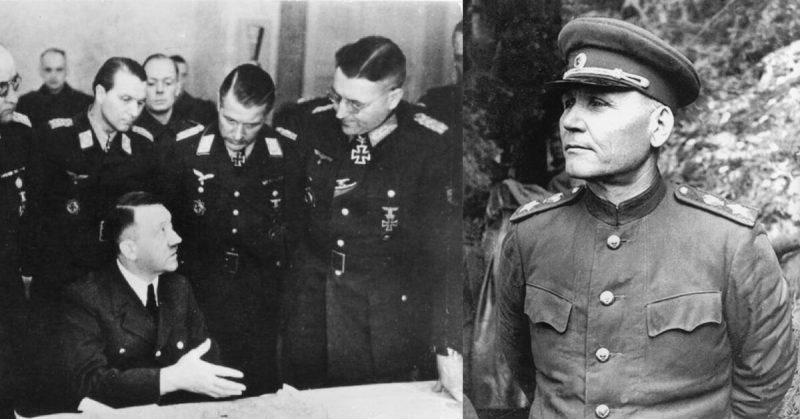During the last days of WWII, anyone with any sense in the German Army was aware of the fact that the lives of their soldiers were being given as offerings to the enemy by their fanatical leader, Adolf Hitler.
Hitler’s days were already numbered on April 24, 1945, when the battle of Halbe Pocket commenced, but the lives of soldiers of the Wehrmacht’s 9th Army could yet be saved.
At least that was what the commander in chief of the 9th Army, General Theodor Busse, considered his duty, despite the Fuhrer’s orders. During the next seven days, Busse attempted a breakthrough from the pocket, hoping to escape the Red Army and surrender to the Allies, seeking better POW treatment.
The battle which took place on the outskirts of Berlin between April 24 and May 1, 1945, was indeed a bloodbath, as the ill-equipped and tired remnants of the 9th Army opposed the vast numbers of troops of the 1st Belorussian and 1st Ukrainian Fronts led by the veteran-commander, Marshal Ivan Konev.
Busse’s men had already suffered a significant blow during the Battle of Seelow Heights, which was still raging when they were cut off and encircled. The 9th Army was a force of 80,000 strong, but with no more than 79 tanks and about 150 armored vehicles.
The Spree Forest in which the Wehrmacht soldiers were trapped proved to be an unforgiving terrain ― lakes, forests, and marshes, all of which slowed down any movement and offered a false sense of safety.
After two attempts to break the encirclement had failed, Busse was desperate. Desperate, but not defeated. On the night of April 28, another mass breakout bore fruit.
A bloody corridor was achieved after members of the 9th Army broke through the 50th Guards Rifle Division. The small victory was costly but necessary. The men’s morale was boosted, as they continued to push westwards.
During the day, the Soviets reinforced their flanks and started a barrage of Katyusha rockets, pouring on the retreating Germans.
Once the corridor was created, discipline was lost. Scattered all over a wide area around Halbe, the rearguard was holding the retreat at Storkow, while the vanguard managed to reach and link up with the 12th Army, under the command of General Walther Wenck at Beelitz. Between the two, there was 80 km of open space.
Russian Marshall Konev coined a strategy in which he used the large stretch of the 9th Army, by splitting the retreating column of Germans into segments. He intended to channel large groups of soldiers, isolate them and hunt them down while minimizing his own casualties and annihilating their enemy.
The Germans had only one strategy ― retreat as far as possible from the Red Army positions and reach the Allied frontline on the west.
The situation was developing fast, turning the Germans to desperate measures. Members of the SS and their Wehrmacht counterparts soon turned to infighting. Each branch accused the other of helping their own while ignoring to help the others escape.
Some children, who had been drafted into the 9th Army as part of their last line of defense, were hidden in civilian buildings. They abandoned their uniforms attempting to avoid death or capture.
In one case, the frightened children sought refuge together with around 40 civilians in a basement of one of the houses. An SS soldier who discovered them during the chaotic retreat decided to be their judge and jury, for their action was in his fanatic eyes nothing but treason.
He pointed his Panzerfaust at the cellar, intending to execute capital punishment upon the little deserters. Luckily he was shot by a Wehrmacht soldier who happened to be passing by and had enough reason preserved in him, despite witnessing the horrors of the war; enough to turn any emotions blunt.
In the next few days, the situation went from confused to crazy. The fighting continued, but there was no clear line of front, just some resisting pockets without any proper chain of command.
A large column of about 25,000 troops was still moving, reaching the all-but shattered 12th Army, and regrouping at Beelitz.
The rest of the 9th Army was once again surrounded west of Luckenwalde, 10 kilometers from the 12th Army with whom they were supposed to link up. The Soviet 4th Guards Tank Army pushed on, spicing their attacks with artillery and assault aircraft, leaving many dead on both sides.
Even though Hitler’s direct orders regarding the 9th Army were to combine forces with the 12th Army and push on, both Busse and Walther Wenck decided to combine forces to establish a corridor towards Allied positions and evacuate as many soldiers and civilians to the west side of the Elbe river as they could.
The remnants of German troops reached the partially destroyed bridge at Tangermünde between May 4 and May 7, 1945, successfully surrendering to the American forces.
This direct violation of Hitler’s orders managed to save up to 25,000 soldiers and several thousand civilians. In the words of Antony Beevor, an English historian, and author:
The most astonishing part of the story is not the numbers who died or were forced to surrender but the 25,000 soldiers and several thousand civilians who succeeded in getting through three lines of Soviet troops.
